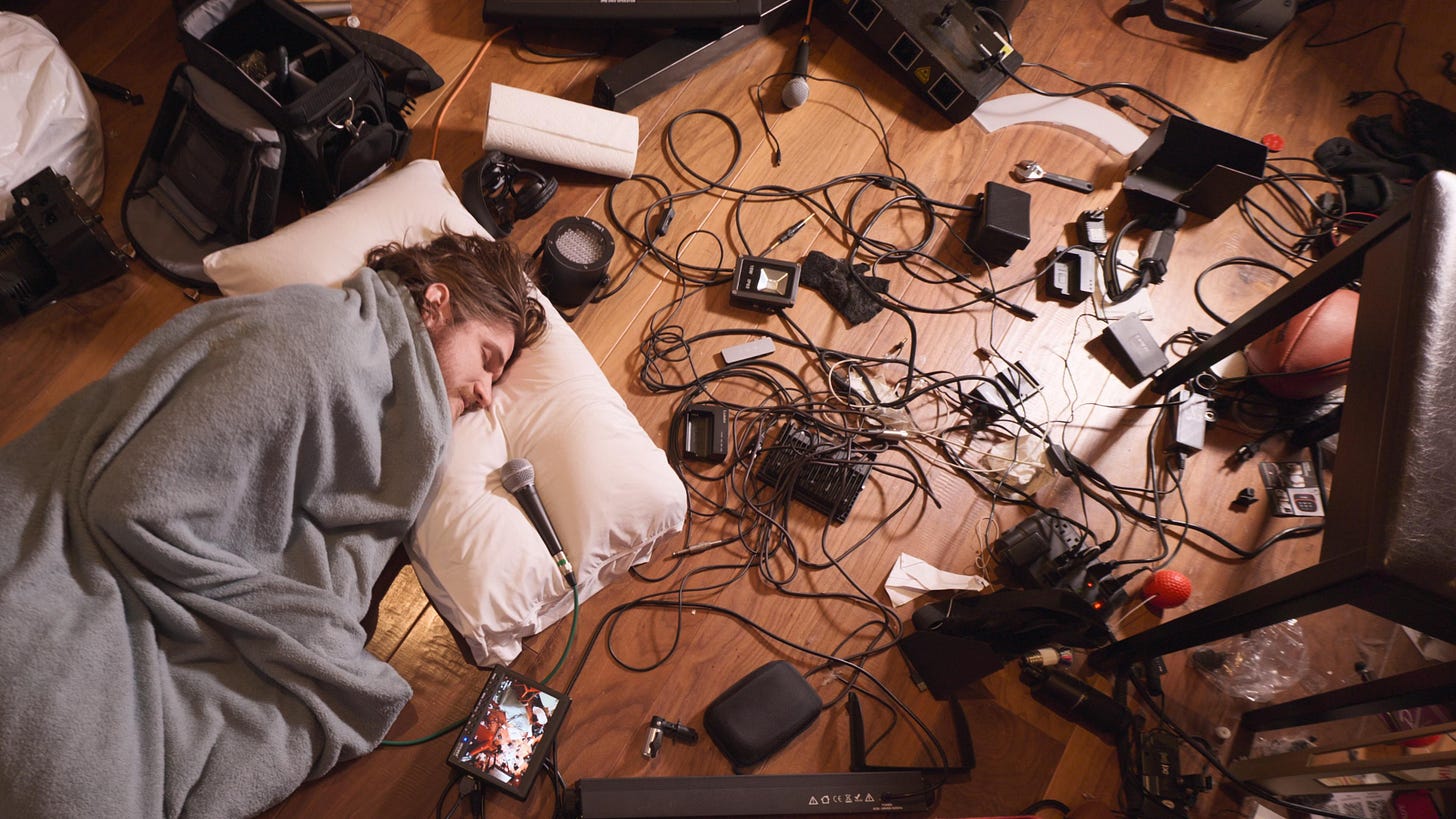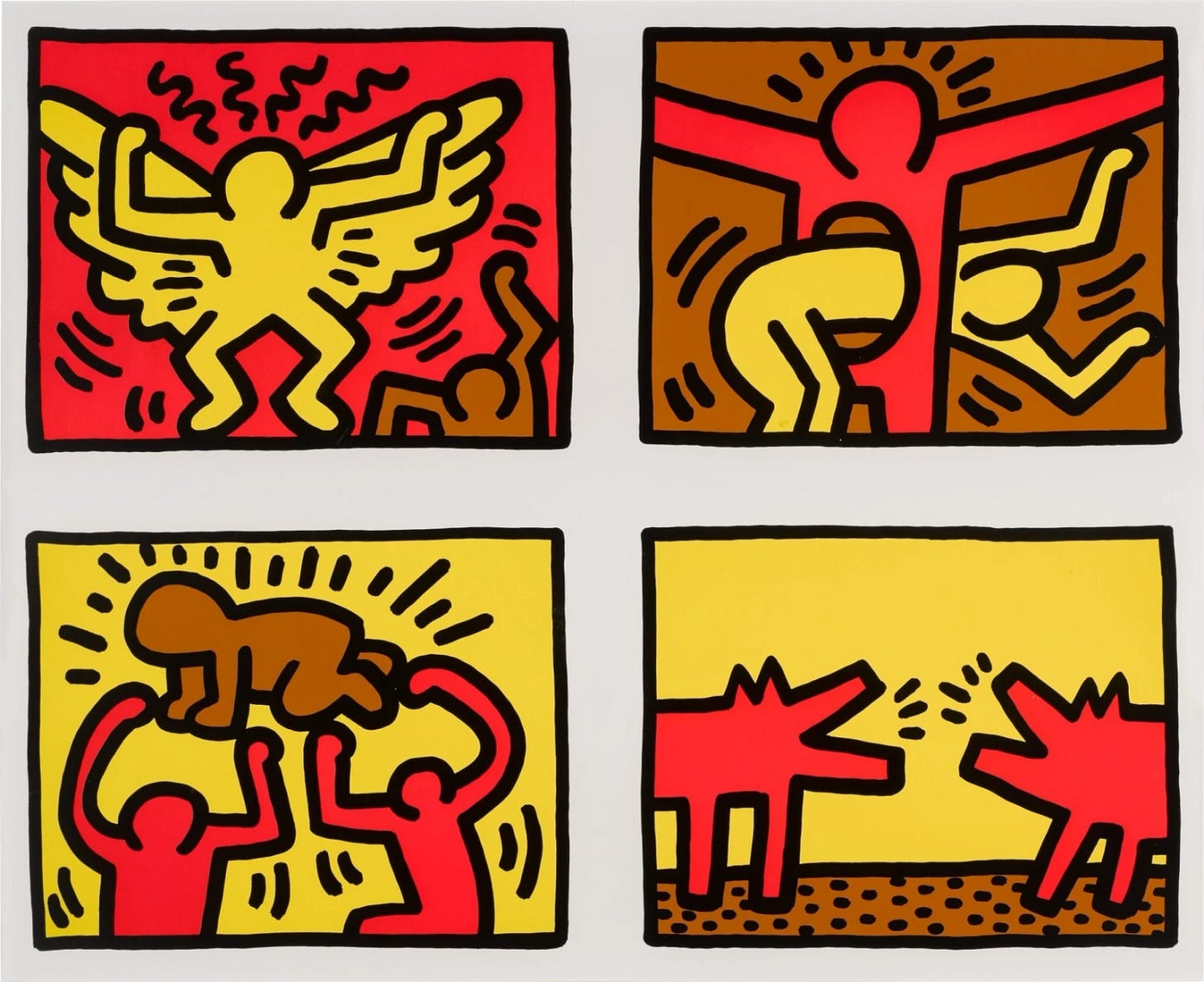
Welcome to Wild Eye Weekly. This week’s a little different because last week was a little different. All the same, what we have here is sure to intrigue. Enjoy. — Jake C.
FILM: Inside (2021)
Thanks to a fascinating piece by
, I was inspired to dive into one of the strangest works the 2020s has yet produced. Lauded upon its debut, ardently defended by fans, yet strangely absent from the present moment, as is its creator. And upon taking it in, years removed from its quarantine context, I do agree with Mr. Pargin that Bo Burnham’s 2021 Netflix special Inside has aged in a very strange way. It has also led me to an equally strange conclusion.Inside was never just a post-modern musical comedy special tied to its era of quarantine and sociopolitical unrest. It was never Mr. Burnham's publicly orchestrated mental breakdown to the benefit of a theatre kid audience in need of a willing, communal effigy.
Inside was an epitaph for the 2010s.
Comatose-inducing "self-awareness." Veiling actual, textbook nihilist misery with a smile and upbeat delivery. The agonized, self-flagellating white guy comedian clad in minimalist wardrobe buried beneath a quantum field of metatextual ironic posturing. Even the shades of 80s synth-pop coloring Burnham's usual show-tune style hints at the last of the decade's nostalgia love-in; a double-whammy given it shares a home with Stranger Things. It represents the seemingly unstoppable force of Millennial culture meeting the immovable object of seismic global events and cultural shifts. A sensation that only grows stronger given how last year transpired in the United States.
It's sincerity for people who have never known sincerity. It's sobering in the way you can see through it once the haze of collective hysteria dissipated and we all stumbled back into the changed world. It's relatable in so much as most will know at least one person in their life as pathetic as this screen-orchestrated edition of Burnham. And I mean pathetic in every sense of the word.
It can be read as me beating this digital piñata of a man I've never met whose comedy I barely recognize. It can be read as me sympathizing and pitying someone driven to the pitch-black depths of their own head, something I and many struggled with during the pandemic. It can be me calling this iteration of the theater kid comedian called Bo Burnham and all he represents as pathetic.
The man who is oh-so on the right side of history, espousing all the most insightful commentaries about what's wrong with the world, but giving into his helplessness so thoroughly he waxes about the woes of letting Big Tech hijack our brains while sitting near-lifeless in a sleeping bag surrounded by the mess of his studio. Truly a catatonic Cassandra for the digital age. Any and all of these readings can be true.
Inside is not only a perfect epitaph for the 2010s, however, but a brilliant antithesis of what one should seek in the modern day. It is a beautifully staged, creatively scored simulacrum of emotional breakdown by a person who has given up on everything and folds in on himself through song. It is incompatible with an age of sincerity, action, and in particular, what the modern male ought to aspire to. No amount of emotional vulnerability is worth being that far up your own ass, wrapped around your colon, and begging for death.
I generally don’t believe in numerically rating films, and will refrain from doing so here for the foreseeable future. As Francis Ford Coppola so brilliantly put it: “what, is the Taj Mahal four stars!?” I do use platforms like Letterboxd (which hosted the initial ramblings of this piece) to rate things for the sake of organization, and what one will notice is that I’ve left Inside blank. The reason: there is no number I can assign this.
I have no emotions to assign to this experience. I don't hate it, I don't love it, but I'm also not indifferent to it. I do not know Bo Burnham as a person, and I know each of his performances is a hyper-curated persona. I'm not interested in the character assassination of the real Bo. I'm interested in the character he creates, but even then, I'm not particularly enamored by the results.
The final piece exists wholly of its time, and at bare minimum is proof that Netflix will gladly publish highly-produced YouTube videos under extremely specific circumstances. And yet, Inside will also remain a premier artistic artifact from the Pandemic Era/the Biden admin/the early 2020s/whatever other distinction you elect to bequeath it, if exclusively thanks to its seismic reception amongst critics, audiences, and video essayists. What all of that means is wholly up to the viewer.
Available on Netflix.
MUSIC: “Hypersleep (97 Revamp)” by Voyager
When I started taking the plunge into the frenetic, flanged world of drum-n-bass music, one track I had stumbled across in my scrolling was this. Delicate electric pianos, rhythms furious-yet-restrained, and a brilliantly used sample of one Ellen Ripley waking up from hypersleep in James Cameron’s 1986 blockbuster sequel Aliens. What follows is the atmospheric sound of the future from 30 years ago, still fresh as ever thanks to masterful production of Pete Parsons.
Available on all major streaming platforms.
FROM THE GALLERY: “Pop Shop Quad IV” by Keith Haring (1989)
Playful, simple, yet always striking, a keystone in Keith Haring’s legacy was his ability to craft art that resonated across all language and cultural barriers while still maintaining that rebellious street art spirit. Whether you knew him for his murals or discovered his style on the way to Sesame Street, that essential component always shone through. This, one of his Pop Shop offerings, enjoys a uniformly warm palette as we see familiar figures and canine pals having all sorts of fun, like beholding angels, babies, and holes in one’s stomach.
SHORT: Fracture (1977)
I’m not sure there is any way I can prepare you for this one. It is an act of purebred surrealism by (who else) the French. Namely two French brothers working in the animation industry. Before Paul and Gaëtan Brizzi lent their incredible skills to modern Disney classics like The Hunchback of Notre Dame and TV favorites like Babar, they created this early work ripped straight from the pages of Métal Hurlant.
A young man of some noble countenance endures a strange series of trials in a desolate land. Any elaboration beyond that would be foolhardy. The only available print suffers the indignity of being a double-letterboxed copy at 480p. And yet, the Brizzi Brothers fuel Fracture with such a cocktail of aesthetics, rolled out at a hypnotic pace, that one starts to see the film in 4K through sheer force of will.
The imposing castles, desolate landscapes, and spherical motif all lull the viewer into a strange state. Not quite depressive; more fascination. That state is amplified tenfold by a wall of mesmeric music from both Tangerine Dream and Edgar Froese’s solo output. The end result leaves you glued to your screen at all costs, even if the ending seems somewhat anticlimactic. Experience it for yourself on YouTube.
FREE SPACE: 42nd Street Memories (2015)
Calum Waddell's 2015 retrospective on NYC's seediest cinema-going street, packed to the rafters with inveterate moviegoers and makers from the time, left quite the impression in a variety of ways. On one hand, the brilliant panel assembled paints a brilliantly vivid picture of what it was like to be there, between the context of the films shown and the actual state of culture at the time, for better and worse. Highlights include historian 42nd Street Pete, Troma's Lloyd Kaufman, William "Maniac" Lustig, and Doctor Butcher MD distributor Terry Levene. On the other hand, the whole piece made me realize something about the classic grindhouse experience I never thought I'd say: I'd have fucking hated it.
I'd have absolutely, without a doubt, not survived a screening. Not because I'd have been stabbed or robbed or raw-dogged in a bathroom stall, but because of the idea of the overactive audience. I attended a single Rocky Horror Picture Show screening in Utica, NY during high school and once was enough. I hated the ridiculous choices of things to shout at, I hated the noise itself, but I enjoyed the film and can count the screening as one off the bucket list. To have to deal with that for nearly every film, on a 2-3 picture program, would’ve seen me hauled away in a paddy wagon with the blood of five junkies on my hands for the privilege of watching the film in damn peace.
What makes it such an odd realization for me is that I adore this era in American history. I love the idiosyncrasies of exploitation film from the time. I did a mini-survey of the "porno chic" era on A Fistful of Film. Some of my favorite moments of ephemera are scenes inside grindhouses like from Midnight Cowboy and Taxi Driver, or great shots of the marquees lit to the nines proclaiming all kinds of shit in films like The New York Ripper.
And yet, with each passing, endearingly-told story of muggings, stabbings, junkies, the "patina" of the theater floor, followed by the most shit-lib complaining about how the street was taken over and re-commercialized into the modern tourist attraction it and Time Square are today (as if the proprietors of these sleaze emporiums were doing it out of the kindness of their hearts), I realized that some things are best left to the past, like dying of consumption and 19th century amputations. I might attend a revival screening someday, as was alluded to in the final film ("we'd run the thing fucking pink" is the greatest slang I've ever heard for screening a film over and over), but I think 42nd Street was best left to a unique, dirty, depraved time and place in NYC history. A period that only those who knew and were there can attest to the charms, something expertly done in 42nd Street Memories.
Available on Tubi.








